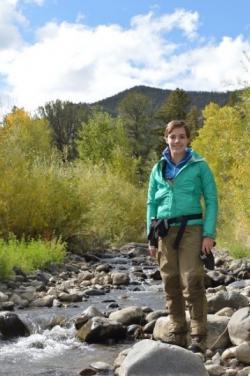Historical Fish Stocking Records may Hold the Key to Saving the Yellowstone Cutthroat Trout
By Adam deLeeuw
16 January 2020

The elusive and beautiful Yellowstone cutthroat trout in Wyoming’s North Fork Shoshone River Basin has been slowly disappearing over the last century, but new insights found by Integrative Biology researcher Prof. Elizabeth Mandeville and colleagues at the University of Wyoming and Wyoming Game and Fish department may point to better conservation strategies.
The cutthroat’s decline is largely attributed to local hybridization and competition with a close relative: rainbow trout. Rainbow trout were introduced to the region by stocking during the last century, and their populations boomed. In addition to rainbow trout outcompeting their native relative, the two species also hybridize, which over time “breeds out” the native cutthroat trout.
“Rainbow trout are one of these amazing species that are introduced around the world but are not usually considered invasive, and yet there is a lot of concern about losing native cutthroat species via hybridization,” says Mandeville.
As part of her post-doctoral research at the University of Wyoming with conservation biologists Annika Walters and Catherine Wagner, Mandeville sampled fish across more than two dozen tributaries of the North Fork Shoshone River. Of the more than 1000 fish sampled, only 2% were true cutthroat trout, whereas rainbow trout made up over 80% of the total count. Hybrids made up the rest.
“We actually found more cutthroat trout than we had predicted based on computer simulations,” says Mandeville. “This suggests that there is something helping to maintain reproductive isolation of cutthroat.”
She and her colleagues set out to predict the location of cutthroat trout “hot spots” that would help identify the best areas to protect through conservation. Because of the difficulty in distinguishing true cutthroat trout from hybrids, the team turned to genetic ancestry.
Ancestry can not only tell you how related a hybrid is to its parent species, it can also describe gene-environment relationships as well. For example, cutthroat trout ancestry can vary along the length of a river, allowing researchers to link the level of cutthroat ancestry with factors like local water temperature or even old stocking locations.
The latter turns out to be extremely important to this story because in addition to rainbow trout, the Shoshone River Basin was also once stocked annually with cutthroat trout.

identification (photo by E. Mandeville)
“A big unknown here was that we didn’t know how much the current distribution of cutthroat reflects the past natural distribution of the fish, and how much it reflects the history of stocking,” says Mandeville. “We were able to consider stocking history as a variable in our model thanks to the dedicated work of Brittany Nordberg, a research assistant at the University of Wyoming who digitized almost a century’s worth of stocking records.
The team identified several native cutthroat ‘hot spots’ that could be predicted in part based on historical stocking of cutthroat tout, a practice that continued until the late 20th century. This means that the old cutthroat stocking locations may now favour the maintenance of cutthroat populations.
This is bittersweet news for fish conservationists. While it is encouraging that these hot-spots exist in nature, they seem largely to occur in places where the cutthroat trout were stocked. This may suggest that truly natural populations are no longer common, at least in the North Fork Shoshone River basin, but ongoing work will clarify the origins of cutthroat trout in this area.
The team plans to delve further into the complexities of hybridization between rainbow trout and cutthroat trout by examining the overlap in the timing and location of spawning between the two fish, as well as the relative reproductive contributions of each species over multiple generations.

E. Mandeville)
“By examining the relative genetic contributions of both parent species to next generation offspring, we can get an idea of whether native cutthroat populations are being maintained, or if they are truly being outcompeted by the rainbows,” explains Mandeville, who will continue her collaboration with her colleagues in Wyoming to further piece together the hybridization puzzle in the North Fork Shoshone river. The tale of rainbow and cutthroat trout represents a challenge in conservation that is far from unique to this region. Species introductions are common and may lead to disastrous consequences for native species. But in Mandeville and colleagues’ study sites, change is being fueled not only by scientists, but also by members of the local community. “People are very attached to preserving elements of the landscape, and this generates political pressure to do something about it,” notes Mandeville.
Jason Burckhardt, Wyoming Game and Fish Department and Karly Higgins, University of Wyoming, also contributed to the study. Funding was provided by the Wyoming Game and Fish Department, the US Forest Service and Wyoming INBRE.
Read the full article in the journal Molecular Ecology.
Read about other CBS Research Highlights.